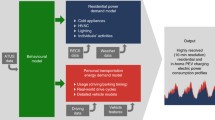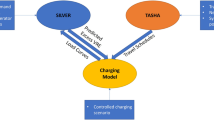Abstract
This paper presents a composite methodology for obtaining spatial and temporal projections of charging demand and peak-shaving potential from plug-in electric vehicles (EVs), and the associated spatio-temporal impacts on peak household electrical load. The methodology comprises a suite of models of future EV uptake, travel by households, household electricity demand and recharge/discharge of EVs at their home locations. The analysis is disaggregated to hourly time-steps over a full year, and spatially to mesh blocks comprising around 250 houses per block. The modelling suite is applied to an analysis of peak household load impacts across the state of Victoria, Australia, under nine different combinations of EV uptake and charging/discharging behaviour. The projected increase in peak household electrical loads under expected penetration rates and charging demands is less than 10 % on most high-demand days, but can be up to 15 % on a handful of days and geographic locations. Peak-load impacts under off-peak charging are mostly less than 5 %. With judicious EV discharging strategies, there is potential to shave peak loads on the highest demand days by up to 5 %.














Similar content being viewed by others
References
Acha S, van Dam KH, Shah N (2012) Modelling spatial and temporal agent travel patterns for optimal charging of electric vehicles in low carbon networks. In: Proceedings of the 2012 IEEE Power & Energy Society General Meeting, San Diego, CA, July 2012
AECOM (2012) Forecast uptake and economic evaluation of electric vehicles in Victoria. Report prepared for the Victorian Department of Transport. AECOM Australia Pty Ltd.
Argade S, Aravinthan V, Jewell W (2012) Probabilistic modeling of EV charging and its impact on distribution transformer loss of life. In: Proceedings of the 2012 IEEE International Electric Vehicle Conference (IEVC), Greenville, SC, March 2012. doi:10.1109/IEVC.2012.6183209
Australian Bureau of Statistics (ABS) (2010) Australian Standard Geographical Classification (ASGC)
Axsen J, Kurani KS (2010) Anticipating plug-in hybrid vehicle energy impacts in California: constructing consumer-informed recharge profiles. Transp Res Part D 15(4):212–219
Boulanger AG, Chu AC, Maxx S, Waltz DL (2011) Vehicle electrification: status and issues. Proc IEEE 99(6):1116–1138
Danish Energy Agency (DEA) (2012) Midtvejsrapport for Energistyrelsens forsøgsordning for elbiler (Danish EV Test scheme—Interim report)
Department of Climate Change and Energy Efficiency (DCCEE) (2008) Energy use in the Australian residential sector 1986–2020
Department of the Environment, Water, Heritage and the Arts (DEWHA) (2009) Energy use in the Australian residential sector 1986–2020
Gardner J, Quezada G, Paevere P (2011) Social study on attitudes, drivers and barriers to the uptake of electric vehicles. CSIRO Australia
Graham P, Reedman L, Poldy F (2008) Modelling of the future of transport fuels in Australia. A report to the Future Fuels Forum. Report No. IR1046. CSIRO Australia
Green RC II, Wang L, Alam M (2011) The impact of plug-in hybrid electric vehicles on distribution networks: a review and outlook. Renew Sustain Energy Rev 15:544–553
Hartmann N, Özdemir ED (2011) Impact of different utilization scenarios of electric vehicles on the German grid in 2030. J Power Sources 196:2311–2318
Higgins A, Paevere P (2011) Diffusion modelling of electric vehicle uptake: methodology and case study for Victoria. CSIRO Australia
Higgins A, Foliente G, McNamara C (2011a) Modelling intervention options to reduce GHG emissions in housing stock—a diffusion approach. Technol Forecast Soc Chang 78:621–634
Higgins A, McNamara C, Xu C, Foliente G (2011b) Modelling for energy efficiency in NSW residential sector. CSIRO Australia
Higgins A, Paevere P, Gardner J, Quezada G (2012) Combining choice modelling and multi-criteria analysis for technology diffusion: an application to the uptake of electric vehicles. Technol Forecast Soc Chang 79:1399–1412
Horn MET (2011) Electric Driveway Project: Battery Electric Vehicle travel model. CSIRO technical report EP114258. CSIRO Australia
Jansen KH, Brown TM, Samuelsen GS (2010) Emissions impacts of plug-in hybrid electric vehicle deployment on the US western grid. J Power Sources 195:5409–5416
Kempton W, Kubo T (2000) Electric-drive vehicles for peak power in Japan. Energy Policy 28:9–18
Langham E, Dunstan C, Cooper C, Moore D, Mohr S, Ison N (2011) Decentralised energy costs and opportunities for Victoria. Institute for Sustainable Futures, University of Technology, Sydney, Victoria, Australia
Maitra A, Kook KS, Taylor J, Giumento A (2010) Grid impacts of plug-in electric vehicles on Hydro Quebec’s distribution system. In: Proceedings of the 2012 IEEE/PES Transmission and Distribution Conference and Exposition, New Orleans, LA, April 2010, pp 1–7
Özdemir ED, Hartmann N (2012) Impact of electric range and fossil fuel price level on the economics of plug-in hybrid vehicles and greenhouse gas abatement costs. Energy Policy 46:185–192
Paevere P, Higgins A (2011) Spatial modelling of electric vehicle uptake and electricity grid impacts in Australia. In: Proceedings of the World Sustainable Building Conference SB11, Helsinki, Finland, October 2011. ISBN 978-951-758-531-6
Papadopoulos P, Skarvelis-Kazakos S, Grau I, Cipcigan LM, Jenkins N (2010) Predicting electric vehicle impacts on residential distribution networks with distributed generation. In: Proceedings of the 2010 IEEE Vehicle Power and Propulsion Conference (VPPC), Lille, France, September 2010, pp 1–5
Ren Z, Chen Z (2010) Enhanced air flow modelling for AccuRate—a nationwide house energy rating tool in Australia. Build Environ 45:1276–1286
Ren Z, Chen Z, Wang X (2011a) Climate change adaptation pathways for Australian residential buildings. Build Environ 46:2398–2412
Ren Z, Foliente G, Chan W, Chen D, Syme M (2011b) AusZEH design: software for low-emission and zero-emission house design in Australia. In: Proceeding of Building Simulation 2011 (BS2011), Sydney, Australia, November 2011
Ren Z, Paevere P, McNamara C (2012) A local-community-level, physically-based model of end-use energy consumption by Australian housing stock. Energy Policy (in press)
Sioshansi R, Denholm P (2009) Emissions impacts and benefits of plug-in hybrid electric vehicles and vehicle-to-grid services. Environ Sci Technol 43:1199–1204
Sioshansi R, Fagiani R, Marano V (2010) Cost and emissions impacts of plug-in hybrid vehicles on the Ohio power system. Energy Policy 38:6703–6712
Taylor J, Maitra A, Alexander M, Brooks D, Duvall M (2009) Evaluation of the impact of plug-in electric vehicle loading on distribution system operations. In: Proceedings of the IEEE Power & Energy Society General Meeting (PES ’09), Calgary, AB, July 2009, pp 1–6
U.S. Department of Energy: Vehicle Technologies Program (2011) The EV Project. EV Project EVSE and Vehicle Usage Report: 4th Quarter 2011. Available online at: http://www.theevproject.com/documents.php
Usher J, Horgan C, Dunstan C, Paevere P (2011) Plugging in: a technical and institutional assessment of electric vehicles and the grid in Australia. Prepared for the CSIRO by the Institute for Sustainable Futures. UTS, CSIRO Australia, Sydney
Usher J, Dunstan C, Ross K, Christie L, Higgins A, Paevere P (2012) Building the electric vehicle market in Victoria: policy and technology options. Report prepared for the CSIRO by the Institute for Sustainable Futures. UTS, CSIRO Australia, Sydney
Van den Bossche P (2010) Electric vehicle charging infrastructure, Chapter 20. In: Pistoia G (ed) Electric and hybrid vehicles: power sources, models, sustainability, infrastructure and the market, 1st edn. Elsevier, Amsterdam
Victorian Department of Transport (2009) Victorian Integrated Survey of Travel and Activity 2007 (VISTA 07). Available online at: http://www.transport.vic.gov.au/vista
Zhang L, Brown T, Samuelsen GS (2011) Fuel reduction and electricity consumption impact of different charging scenarios for plug-in hybrid electric vehicles. J Power Sources 196:6559–6566
Acknowledgments
The authors gratefully acknowledge the Victorian State Government (led by the Department of Transport), SP AusNet and the CSIRO Energy Transformed Flagship for co-funding this research. We would also like to acknowledge our CSIRO and University of Technology, Sydney, colleagues for their contributions to various underpinning research activities—John Gardner, Chris Phyland, Tarek Elgindy, Yong-Bing Khoo, Greg Foliente, George Quezada, Dong Chen, Mingwei Zhou, Josh Usher, Chris Dunstan, Katie Ross, Leigh Christie and Conal Horgan.
Author information
Authors and Affiliations
Corresponding author
Additional information
Handled by Osamu Saito, UNU-Institute for Sustainability and Peace (ISP), Japan.
Rights and permissions
About this article
Cite this article
Paevere, P., Higgins, A., Ren, Z. et al. Spatio-temporal modelling of electric vehicle charging demand and impacts on peak household electrical load. Sustain Sci 9, 61–76 (2014). https://doi.org/10.1007/s11625-013-0235-3
Received:
Accepted:
Published:
Issue Date:
DOI: https://doi.org/10.1007/s11625-013-0235-3




